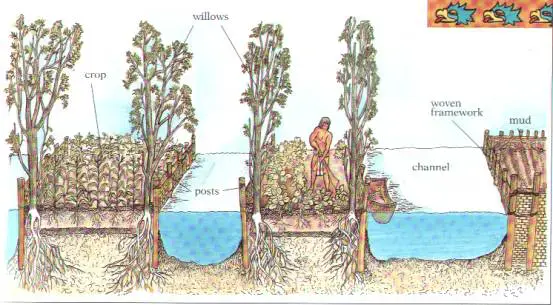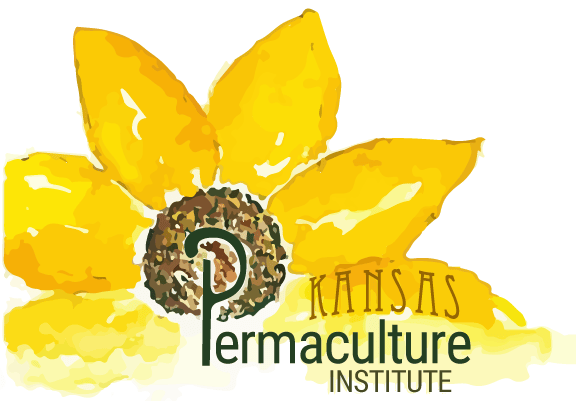Using Permaculture Methods to Address Growing Sustainable and Healthy Food
There are many ways of growing food using the methods defined by Permaculture Design.
One could spend a lifetime learning and using them. No one way fits all needs.
There is no one way that is better than the next. They all work depending on the effort you
put into the method and of course, the environment that you are working in. What works well
for you may not work well for me nor be preferred by me. We are all looking for the method
that allows us to grow healthy food using the least amount of effort, resources and have the
least effect on the environment.
For just over 18 months I have been studying a couple of methods of growing food that I am
finding addresses several tenets of good Permaculture Design. I am studying at the K-State
Olathe Campus, in the Urban Agriculture Division. My original desire was to learn about
Aquaponics, but I have found a desire to learn about Hydroponics as well. While taking
these classes I am finding that these growing methods meet many of the Design Principles of
Permaculture. If you have studied Permaculture Design you will probably remember reading
about Chinampas, a growing method favored by the Aztecs. Aquaponics is a very similar
growing technique.

https://midwestpermaculture.com/chinampas-gardens/
A summary of each:
Aquaponics focuses on growing leafy greens, herbs, edible flowers, and some fruiting
vegetables. The raising of fish, in a fish tank, creates a waste stream that is converted into
the nutrients that are needed by the plants being grown. Fish waste is filtered by a variety of
techniques so that the bad bacteria are removed and replaced by beneficial bacteria, leaving
behind the good nutrients that the plants can use. The plants sit on a floating raft with only
the plant roots in the nutrient-rich water. As the plants use the nutrient-rich water, they are
also cleaning the water and making it fresh again to be reused in the fish tank.
Hydroponics focuses on growing leafy greens, herbs, edible flowers, and a large variety of
fruiting vegetables. Where Aquaponics uses fish to provide the required nutrients,
Hydroponics relies on us adding the required nutrients to a tank of water that is then
supplied to the plants to use. Here again, we are feeding just the roots of the plants.
So, what is so great about these growing methods? Well for one they use about 90% less
water than the same crops grown in the field. Due to the density at which they can be grown,
you can grow more in less space. There is no soil in the growing process. No need to
constantly be amending the soil or pulling weeds. For fruiting vegetables with larger root
systems an inert medium is used for the roots to hold on to. Materials like Perlite and
Vermiculite are often used instead of soil. Remember, the system is providing the required
nutrients, not the soil. Most of these systems use a high tunnel or greenhouse to grow in. In
many newer applications, these systems reside in a building. On a small-scale backyard
application, the system may just be in the yard with no overhead covering. While the jury is
still out, there are some reports vegetables grown by Aquaponic or Hydroponic
methods are just as nutritious as those grown in the ground. And do they taste better? We
may need another jury.
By taking the system into the high tunnel, greenhouse, or building, we gain several more
advantages. The first advantage is we no longer need to worry about crop damage caused
by heavy rain, snow, hail, or strong winds. Being inside a structure greatly reduces your pest
load and the occasional raid by Peter Rabbit, Rocky the Racoon, or Bambi and her Clan.
Granted some things need to be addressed when growing indoors. High
tunnels and greenhouses with their poly and glass covers can build up a lot of heat inside,
methods of removing that heat need to be used. Often shade covers are used to reduce the
buildup of heat. A high tunnel and greenhouse may be limited to the length of the growing
season unless a method of heating the space is used during the cold season. Buildings on
the other hand will need to address several areas of concern but may provide the best
growing environment for year-round food production. Heating and cooling the building will
be required, but here we could maintain an optimum temperature range that suits the
growing conditions of the plants being grown the entire year. Humidity levels will need to be
addressed as well of a good supply of fresh air. And let’s not forget the need for Sunlight.
Wait the building does not allow ample Sunlight into the grow space? Not to worry,
advances in LED Grow Lights have you covered. In fact, the technology is advancing to the
point that the LED lighting system can provide the correct wavelength of light needed for
various stages in the plant’s growth cycle. Thanks in part to advances in AI and computer
technologies. Just the right amount when needed, no more, no less. We should also
mention the use of chemicals and pesticides. Well, there are none. What pest management
that might need to be addressed can be resolved with typical organic-type pesticides. Ones
that have no adverse effects on the plants, the fish population, or humans. No chemical
weed killers. No chemicals are required for soil amendments. The only chemicals added may be
macronutrients that the fish are not providing. On the Hydroponic side, we are mixing
macronutrients in the water as well as some other nutrients such as magnesium, iron,
copper, and manganese just to name a few. And these are added only as needed.
Let’s take a minute to review what many see as some of the benefits to Aquaponics and
Hydroponics. In both grow methods we are controlling the nutrient needs of the plants being grown, 24 hours a day, 7 days a week. What we harvest today will be the same we harvest
tomorrow and next month. We have repeatability in our harvest. We have limited damage
due to the outside environment. We will be using 90% less water and use less space to
grow an abundance of food. We will however have an increase in electrical usage which
many will see as a disadvantage. The advances in the solar panel industry and battery
storage development could easily manage this need. Even better if your system is grid-tied.
Now let’s look at what a small system might produce in a single growing season. What if we
had a 30’x72’ High Tunnel. Surely most of you reading this article can visualize this amount
of growing space. We will assume for this that we have available to us a 35-week growing season.
What if we wanted to try our hand at both Aquaponics and Hydroponics in this growing space?
For this exercise, we will give each system ½ of the available space in the high tunnel. What
might we be able to produce? The Aquaponic system would consist of an 8’ x 48’ Deep
Water Culture Bed (DWC). This is a water trough that the rafts sit on to grow our leafy
greens. We will use two 300-gallon fish tanks to provide the nutrient needs of our growing
system. The Hydroponic system will include 2 different growing techniques. One is called
Nutrient Film Technique (NFT). Imagine plastic rain gutters. Here the nutrient-rich water
dribbles past the roots several times a day. The second is what we call the Dutch Bucket or
Bato Bucket Technique. This is where we use the Perlite as our grow medium and drip
irrigation to provide the required nutrients for our fruiting vegetables.

- From one grow season this is what we might expect to harvest.
- Harvest potential from Aquaponics:
- 252 leafy greens harvested per week.
- 35-week season equals a yearly harvest of 8,820 plants.
- End-of-season fish harvest, around 200, 1.5-to-2.0-pound fish, most likely Tilapia.
- Harvest Potential for Hydroponics:
- 75 leafy greens harvested per week.
- 35-week season equals a yearly harvest of 2,625 plants.
- Dutch Bucket System 1, Tomatoes, harvest around 35 pounds per plant.
- 46 Tomato plants would yield about 1,620 pounds per season.
- Dutch Bucket System 2, Cucumbers, harvest around 60 pounds per plant.
- 46 Cucumber plants would yield about 2,760 pounds per season.
- Dutch Bucket System 3, Strawberries, harvest around 1 pound per plant.
- 225 Strawberry plants would yield about 225 pounds per season.
This is what we might expect if all system and plant parameters are met. Remember, in this
exercise, we are growing all of this in a 30’x72’ high tunnel. We have used the high tunnel
footprint to yield the most produce without overcrowding the plants.
This is a fairly high-level look at Aquaponics and Hydroponics. Will Aquaponics and
Hydroponics replace growing in the garden or in the fields? I do not think that will be the
case. I do believe that both methods provide an opportunity to grow an abundance of food
in a small footprint, whether that is in the backyard, high tunnel, greenhouse or in a building.
In a time where the population is growing, especially in urban areas, and a time where more
and more of our food is trucked in from far away, often not edible by the time it reaches the
store shelves, maybe it’s time to look at other methods to grow more healthy food. Grow it
locally and grow it in a sustainable manner.
Where does Permaculture Design come into this you ask? We could probably devote an
entire Meetup to discuss this. Here are a few of them that come to mind.
Creatively use and respond to change. The climate is changing. Water usage could be a
concern in the future. Urban Centers yearn for more locally grown, healthy and nutritious
food. There is a desire to grow more food in less space closer to urban populations.
Use edges and value the marginal. In the described exercise we defined our grow space
and used as much of it as possible. Aquaponics and Hydroponics can be used on land not
favorable for growing crops in the ground. Remember the Chinampas, water holding up rafts
to support plant growth.
Design from patterns to details. With this one, I think we remember the work of the Aztecs.
They designed these systems back in the 14th -16th centuries C.E. Repeating work already
demonstrated and being most successful is always a good choice.
Produce no waste. In Aquaponics, the water is in a closed-loop system. A waste stream is
turned into a valuable resource to nourish plants. In Hydroponics nutrient-rich water can be
used once or recycled. If sent to drain it is typically not very much water. This nutrient-rich
water could be collected and used in your garden instead of going down the drain.
Vegetable leaves and root systems not sent to market can easily be used in the compost
pile.
Use and value renewable resources and services. Typically, 90% less water is used. The
water that is in use is continually in use and replenished by being cycled back into the fish
tank to start the process all over again. Ample Sunlight should be available in most
applications, however, where LED lighting is used the electrical requirements are far less
than conventional greenhouse lighting systems. LED energy usage drops with each new
generation of lighting. Solar power with batteries and maybe a backup generator could be
used to provide all or most of the energy required to operate this type of growing system.
Obtain a yield. From the exercise above I think we have shown where a system like this can
produce an abundance of food. Once the Aquaponics system is set up and running there
are a few additional inputs, seeds for plants and feed for fish, and perhaps a few macronutrients to
balance out the nutrient needs for the plants.
There are currently only a small handful of farmers that I know of, near our farm, that are
using Hydroponic grow methods. There have been a few Aquaponic systems, but they
seem to have come and gone. There exists an opportunity to explore these techniques to
address potential shortages of locally grown healthy food in our local and regional food hub.
I am looking into this. It is my hope that by the time summer arrives I will have an
Aquaponics and Hydroponic System set up here at Greenman Farm. A place to grow
nutritious food and a place to learn how to grow food using both technologies in a
sustainable manner.
Bill Price
Kansas Permaculture Institute
Board of Directors Member
Dated: 03/18/2024

